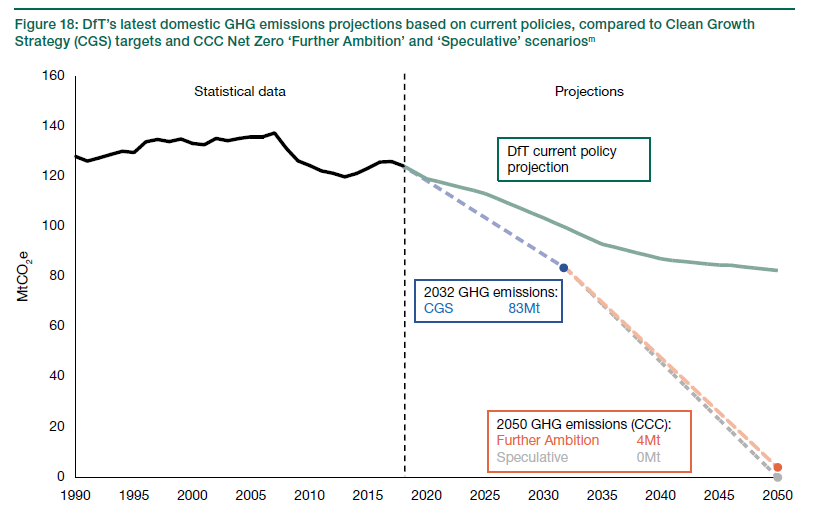by Greg Marsden
Thursday marked the long awaited launch of the first stage of the Department for Transport’s Decarbonisation Plan. It is perhaps not the most eye-catching news item in what is a pretty traumatic period for the UK but it does deserve the attention of everyone in the sector and, as events allow, the UK population.
The title, “Decarbonising Transport: Setting the Challenge”, is deliberate. This is not the plan, but an invitation to shape the plan over the next 6 months. The document provides a very transparent view of the nature of the challenge; as shown in the size of the gap between the trajectory implied in the 2017 Green Growth Strategy (not as ambitious as it needed to be) and the current committed policies (of which there is an impressive list).

The science has a significant influence on the framing including:
“This is not optional; There is no plausible path to net zero without major transport emissions reductions; reductions that need to start being delivered soon.” (p58)
There is an acknowledgment that there will need to be a strategy which covers all technologies and all modes and, critically, which involves significant and early action – given the time it takes for technologies to penetrate the fleet. Some of these technologies do not even exist yet and form part of the call to arms for science and innovation.
From the perspective of the DecarboN8 Network, we are delighted to see an emphasis on ‘Place-Based’ decarbonisation, which forms one of the six strategic priorities set out in the document. The plan highlights variations in commute mode shares and levels of on-street parking (and therefore charge point access) in different communities. As the plan develops, it should also address the huge variations in carbon emissions between local authorities, their very different options for decarbonisation, and, their different pathways to zero carbon which will need to be worked out.
As a line in the sand on what we know about transport and carbon and what the existing policy commitments will and will not achieve, this document will stand the test of time. The big question, however, is what happens next? What does an ambitious pathway look like? What is the mix of measures that take us there?
The number of stakeholders is huge, the range of uncertainties significant and the policy choices difficult. Now is the time to make the case for a progressive, effective and ambitious trajectory that maps to the UK’s carbon budget as implied by the Paris Agreement (if events allow).
Some of the issues which stand out in the document for me include:
- The language of providing easier choices to travel by walking, cycling and public transport. The same applies to better information on CO2 to inform travellers. We’ve been here before. The context of choice matters. The document talks about what we will improve, but not what will be restricted. If issues like pricing of public transport are left out, then the price signals do the choosing more clearly than any carbon calculator ever could. There is not a word on restricting car use.
- There remains a chronic imbalance in spending on making things better for car drivers versus those travelling by lower or zero emission modes. £532m for three years of extension to the Plug-In Car Grant versus £350m for cycle infrastructure funds for example. I am not arguing to cut the Plug-In Car Grant – but rather that we need to be more ambitious than just increasing cycling from 1% to 2% of distance travelled, and we must fund that commitment properly. The £27bn spend on major roads schemes announced around the budget was not mentioned. For this decarbonisation plan to work it must be at the heart of all decisions in Whitehall – it must move from being a stand-alone statement to one which matters everywhere.
- There are some parts of the transport system which are going to decarbonise very slowly. With all current commitments on LGVs, emissions may only be 17% lower by 2050. Maritime also has real challenges, as does aviation. If we cannot cut these emissions quickly enough then it will fall to the rest of the sector to compensate. Given the already colossal challenge of decarbonisation of car technology, what this really means is yet more emphasis on demand reduction. Demand reduction is not specifically addressed within the document, at least not the reductions of 20% and upwards which will require major national and local intervention and a plan to grow the economy differently – reductions which cannot be achieved by nudge. One thing we might salvage from the current Covid-19 crisis may just be the opportunity to change this debate and decide to rebuild differently.
- Finally, I was disappointed to see that the carbon impacts of infrastructure were left to other sectors to consider, as they don’t neatly fit within the carbon accounting protocols for transport. Whilst EVs are lower carbon than petrol cars they are not zero emission and the materials and recycling processes they require are significant. Emissions in construction also matter. The DecarboN8 Network will be working with stakeholders across the North to show just how important it is to take integrated rather than siloed decisions about the total carbon impacts of transport.
I am sure there are many more issues to be debated. I will be doing my best to play a part in those discussions and working hard with our DecarboN8 partners to fill some of the research and implementation gaps. If you like what the DfT have put out, then please take this opportunity to say so – it has been a long road to get here. If you want to see more ambition or a different emphasis then jump up and down and get involved in the discussion. We will see you there!
